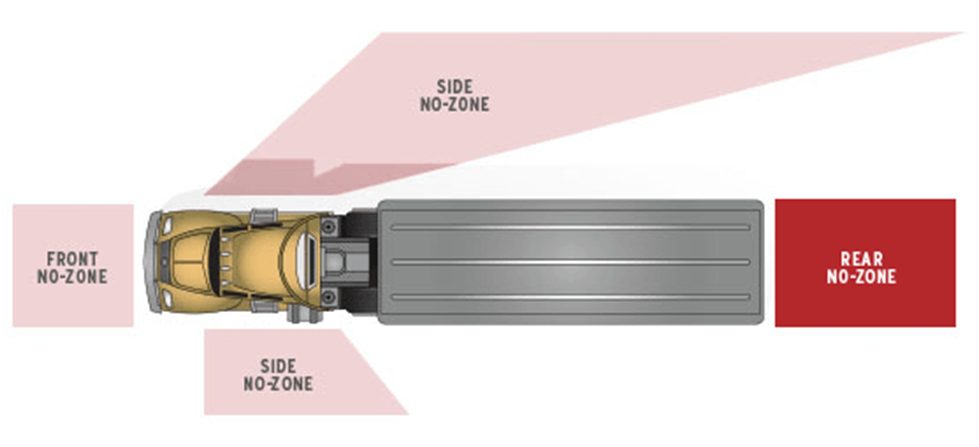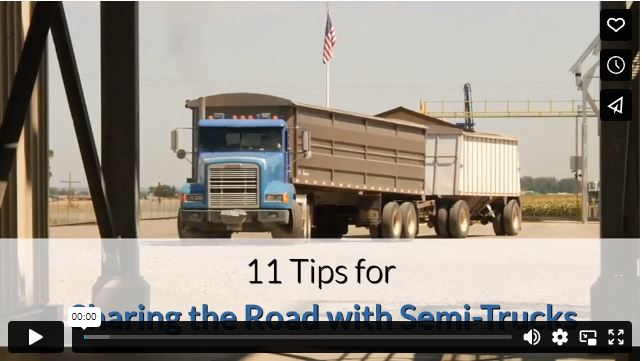America’s track record for trucking accidents is not trending in a good direction. According to the National Highway Traffic Safety Administration (NHTSA), there was a 9 percent increase in trucking fatalities in 2017, marking the highest death toll in 29 years. Deaths from truck crashes continued to climb in 2018 by about 3 percent with nearly 4,800 people dying from accidents involving large trucks.
There are about 3 million commercial trucks on America’s highways. They keep the country running as they haul freight from east to west, but they are also powerful weapons. We have seen tremendous tragedy resulting from trucking accidents, and the vast majority of the injuries affect drivers and passengers of the other vehicles—not those in the trucks.
While some of these crashes are unavoidable, others can be prevented with increased awareness and care on the part of drivers. To help you stay safer on the roads, we’d like to share tips for driving safely around semi-trucks.
1. Know where their blind spots are. Some people assume that because trucks sit higher off the ground, they have full visibility of the road. This is not the case. In fact, trucks have to contend with four major blind spots (also referred to as “no-zones”):
- One directly in back of the truck
- One in front of the truck
- One on the right side of the truck that can cover several lanes
- One on the left side of the truck that can at least cover one lane

(Source: Utah Department of Transportation)
2. Pass quickly. Driving alongside a truck in their blind spot is begging for trouble. If you need to pass a truck, do so quickly so that you can get out of their no-visibility zone as quickly as possible.
3. Allow trucks to pass. When trucks are trying to pass your car or other vehicles on the road, stay to the right and allow them to complete the action. Do not speed up or cut in front of them. The same principle applies when a truck is merging. Allow them plenty of space to do so, which may mean that you need to slow down significantly to let them in.
4. Watch for turn signals. Trucks often need a wide berth to turn. Keep a close eye on their turn signals and stay out of their way. Many accidents are caused by drivers trying to speed by a truck on their right side while the truck driver is trying to maneuver a right-hand turn.
5. Don’t pull in front of trucks. Semi-trucks can carry up to 80,000 pounds. It takes some time to stop the force of a load like that, and a trucker’s reaction time may be delayed if you’re pulling in front of them from a blind spot and catching them by surprise. By the time they see you, it may be too late for them to engage their brakes as needed. A good rule of thumb is to leave a distance of five to six cars in front of big trucks. The last thing you want is to be rear-ended by a big truck because you pulled in front of them too closely.
6. Don’t slam on your brakes. In light of a truck’s slower response time, make sure that you aren’t slamming on your brakes while driving in front of a truck. Always watch for brake lights in front of you so that you can slow down gradually, allowing the truck behind you to do the same.
7. Don’t tailgate. If you follow a truck too closely, you’ll be in their rear blind spot. Allow several car lengths for optimal safety. This can also protect you if the truck blows out a tire. The force of a blown-out truck tire flying into your windshield is similar to the force of being hit by an actual truck.
8. Watch their mirrors. A good general rule is that if you can’t see the truck driver in his or her side mirror, you can assume that you are in their blind spot and they can’t see you.
9. Give them space in bad weather. In good conditions, it takes a fully loaded truck the distance of about two football fields to stop. In bad weather, you can count on even more. Allow an even greater distance in front of and behind trucks in inclement weather.
10. Don’t pass trucks on downgrades. Trucks pick up speed on downgrades, making it even more difficult for them to stop. Stay out of their way on downgrades, waiting for the road to level out again before you pass.
11. Be patient. Accidents happen when people are in such a hurry to get where they’re going that they refuse to share the road. Be patient with trucks, realizing that they are dealing with far more weight and size than you are. Allow them to take the time needed to get up to speed without zooming around them and potentially causing an accident. This may cost you a couple more minutes on the road, but it will help ensure your safety and theirs.
In addition to these safe-driving tips, remember to buckle up. According to the Centers for Disease Control, seat belts reduce the risk of fatalities for front seat drivers and passengers by 45 percent. They reduce the risk of serious injury by 50 percent. You can’t control a lot of things that happen on the road, but you can control your seat belt. Never leave your destination until you have buckled up.
These tips can help you stay safer on the road, but they aren’t foolproof. No matter how carefully you share the road, accidents still happen. If you are injured due to the negligence of other drivers, contact a car wreck lawyer in Las Vegas. They can help you receive the best medical care and recover your financial losses, to include property damages, ongoing medical bills, lost wages, and loss of capacity.
Trucking accidents can be devastating, and the other driver’s insurance will be looking out for their own best interest—not yours. The experienced attorneys at Tingey Injury Law Firm won’t be fooled by their tactics. They can stand up to Big Insurance and fight for your rights while you focus on healing and moving forward with your life.
Video

